Performed by: Tsun Iosif Mendelevich, Professor, Department of Algebra and Geometry, Moscow State University, Candidate of Technical Sciences

Basic construction 2 Put aside the angle equal to the given angle from a given ray in a given half-plane. Construction: Given: With a center at point O, draw an arc of arbitrary radius crossing the sides of the corner at points M and N. A BN M FN M O S With a center at point S with the same radius, draw an arc in a given half-plane. Let it intersect SF at point N. We measure MN with a compass and set aside from N on the previously constructed arc with center at point S. We get M. We draw the beam SM. MSN angle - required.
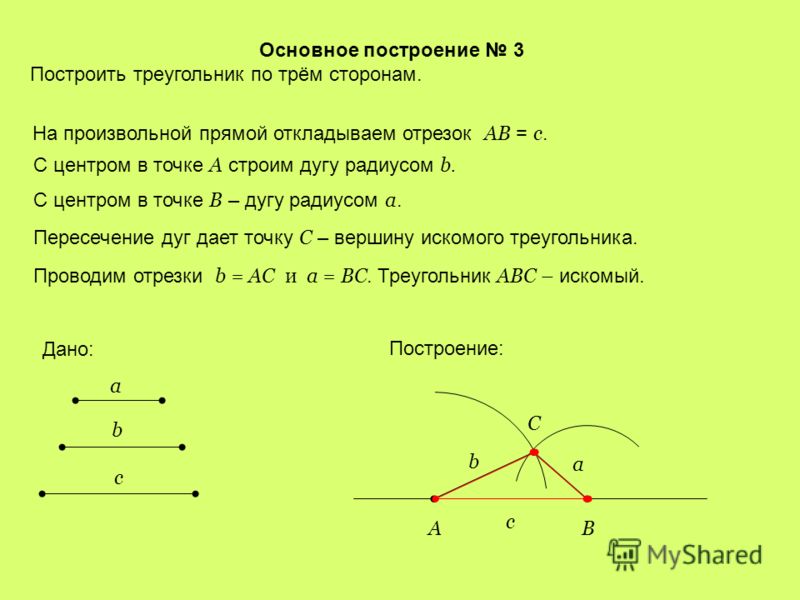
Basic construction 3 Draw a triangle on three sides. On an arbitrary line, put off the segment AB \u003d c. Construction: Given: a b c AB C c b a With center at point A, construct an arc of radius b. With center at point B - an arc of radius a. The intersection of the arcs gives the point C - the vertex of the desired triangle. Draw segments b \u003d AC and a \u003d BC. Triangle ABC - required.

Basic construction 4 Draw a triangle on two sides and a corner between them. On an arbitrary line, put off the segment AB \u003d a. Construction: Given: a b AB C b a Using basic construction 2, we construct an angle with a vertex in A. On the second constructed side of this angle, put off the segment AC \u003d b and get the third vertex of the desired triangle ABC.
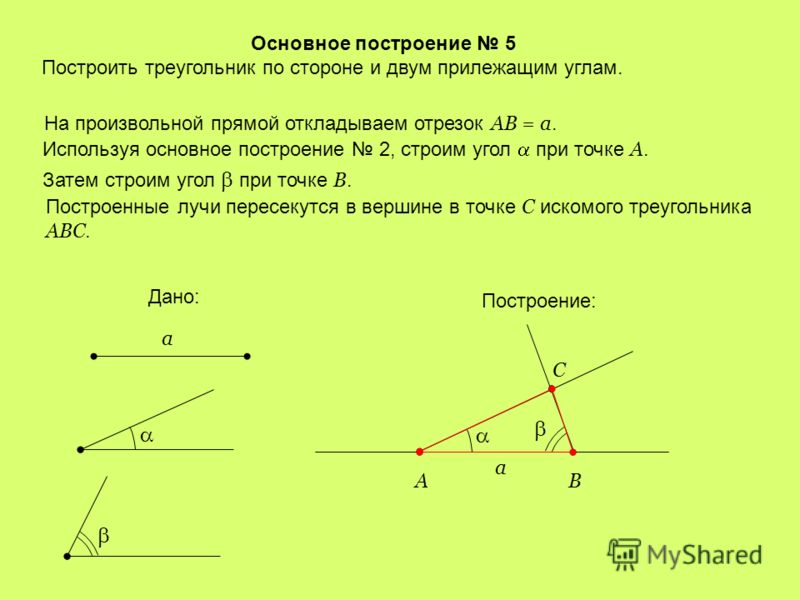
Basic construction 5 Draw a triangle on the side and two adjacent corners. On an arbitrary line, put off the segment AB \u003d a. Given: a AB C a Construction: Using the basic construction 2, we construct the angle at point A. Then we construct the angle at point B. The constructed rays intersect at the vertex at point C of the desired ABC triangle.
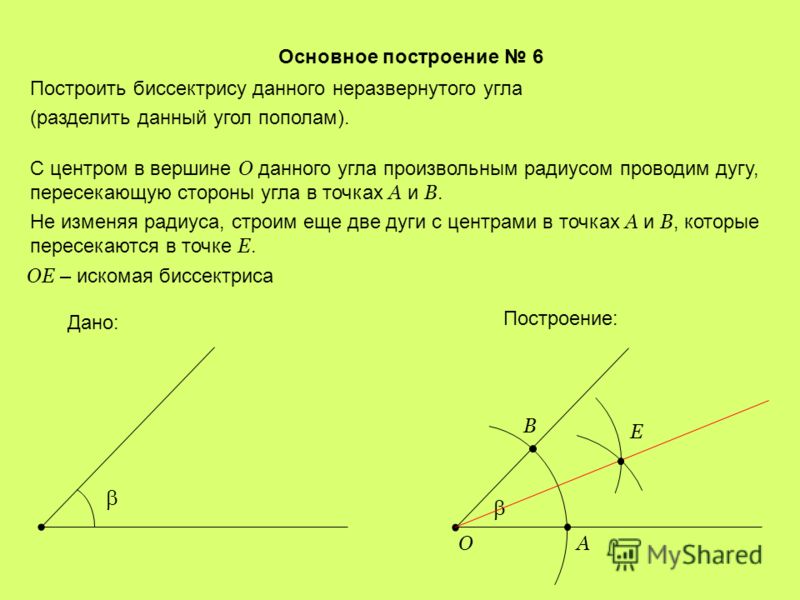
Basic construction 6 Build a bisector of a given non-expanded angle (divide this angle in half). Construction: With a center at the vertex O of a given angle with an arbitrary radius, draw an arc crossing the sides of the corner at points A and B. BAE Given: Without changing the radius, we construct two more arcs with centers at points A and B that intersect at point E. O OE - desired bisector
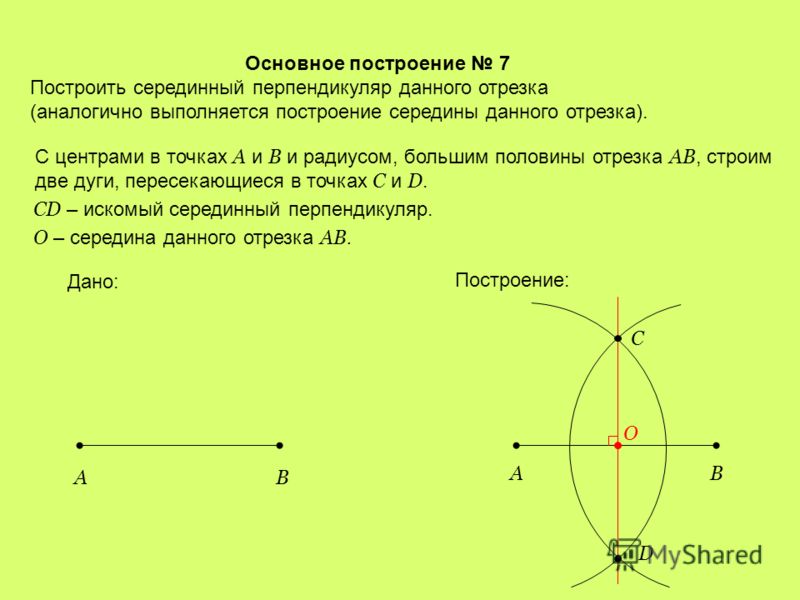
Basic construction 7 Construct the middle perpendicular of a given segment (the construction of the middle of this segment is similarly performed). With centers at points A and B and a radius greater than half of the segment AB, we construct two arcs intersecting at points C and D. Construction: AB C D O Given: AB CD is the desired middle perpendicular. About - the middle of this segment AB.
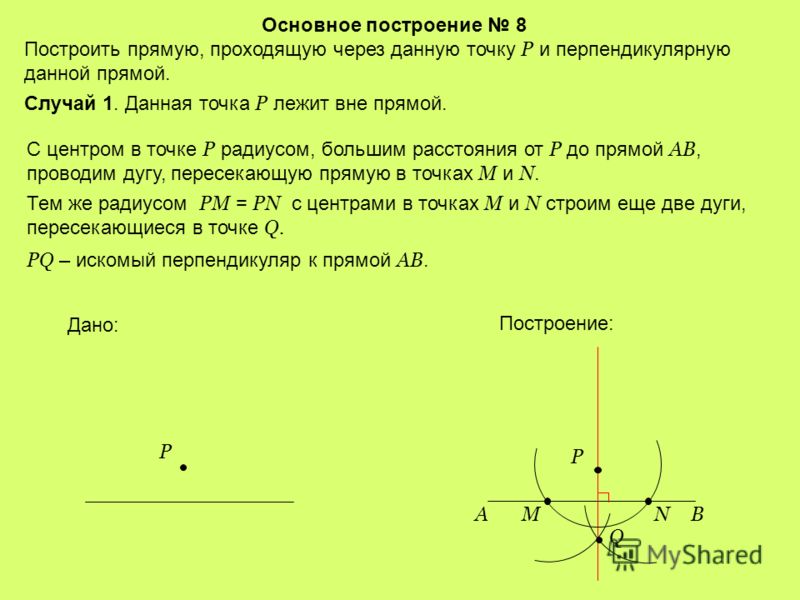
Basic construction 8 Build a line passing through a given point P and perpendicular to this line. Case 1. This point P lies outside the line. With a center at point P with a radius greater than the distance from P to the line AB, draw an arc intersecting the line at points M and N. AB MN PQ Construction: P Given: Using the same radius PM \u003d PN with centers at points M and N, we construct two more arcs intersecting at the point Q. PQ is the desired perpendicular to the line AB.
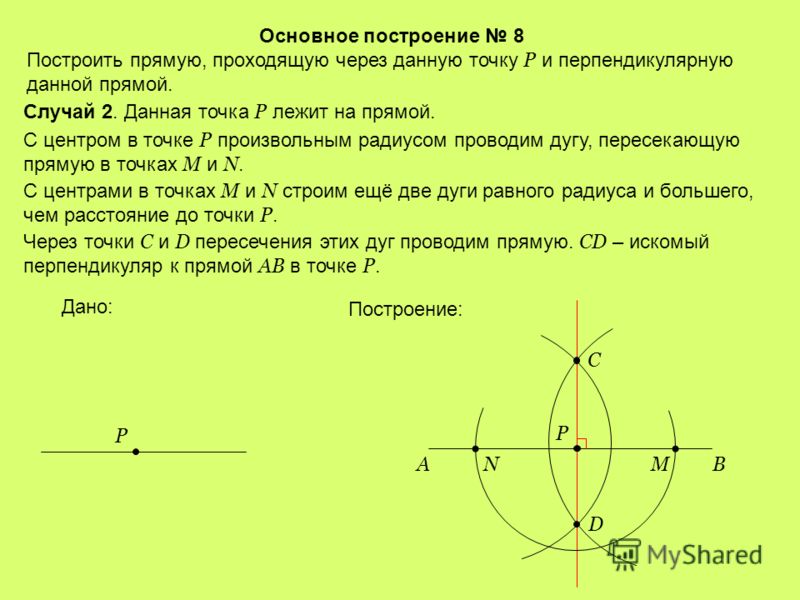
Basic construction 8 Build a line passing through a given point P and perpendicular to this line. Case 2. This point P lies on a line. With a center at point P of arbitrary radius, draw an arc intersecting the straight line at points M and N. NM CDPAB Construction: Given: With centers at points M and N, we construct two more arcs of equal radius and greater than the distance to point P. Through points C and D intersection of these arcs draw a straight line. CD is the desired perpendicular to the line AB at point P. P
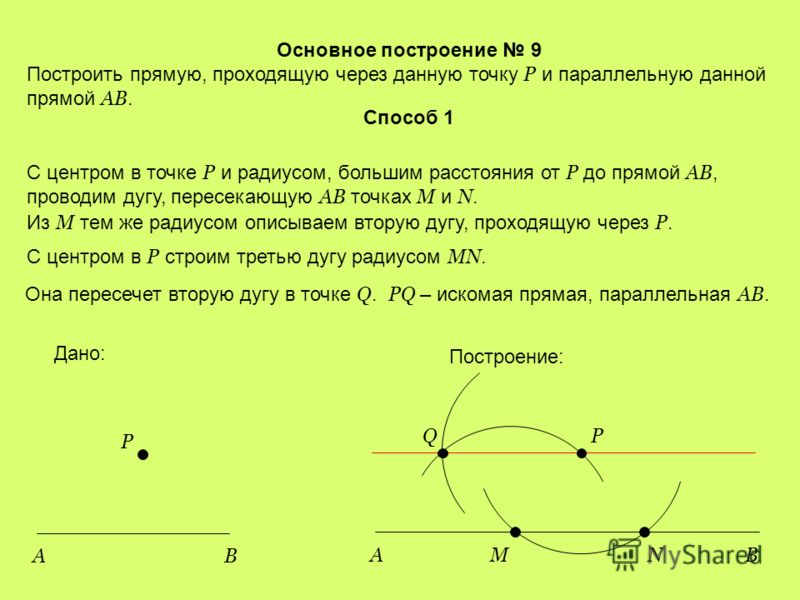
Basic construction 9 Construct a line passing through a given point P and parallel to a given line AB. Method 1 Construction: With a center at point P and a radius greater than the distance from P to the straight line AB, draw an arc crossing AB at points M and N. P MN QP AB Given: From M with the same radius we describe the second arc passing through R. It intersects the second arc at the point Q. PQ is the desired line parallel to AB. AB With a center in P, we construct a third arc of radius MN.
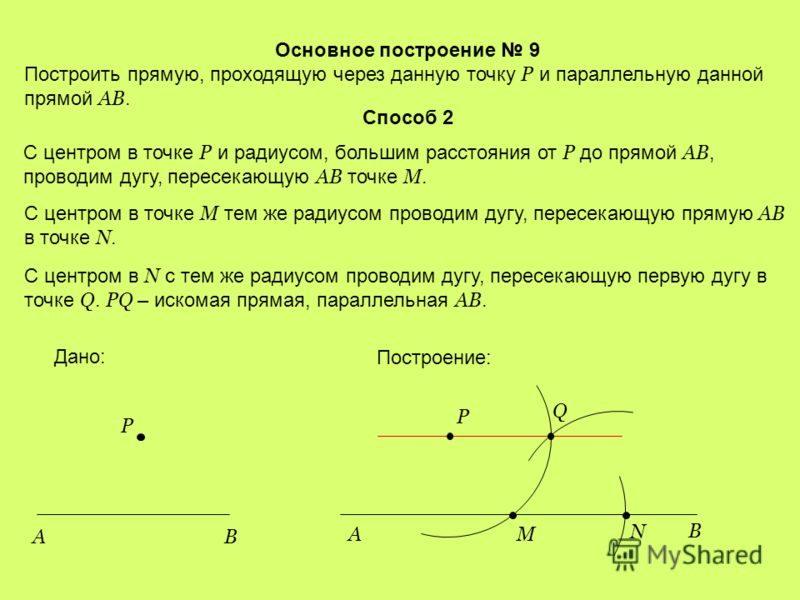
Basic construction 9 Construct a line passing through a given point P and parallel to a given line AB. Method 2 With a center at point P and a radius greater than the distance from P to the straight line AB, draw an arc intersecting AB at point M. Construction: PMNQP AB Given: A B With a center at point M with the same radius, draw an arc crossing straight line AB at N. With a center in N with the same radius, draw an arc crossing the first arc at the point Q. PQ is the desired line parallel to AB.
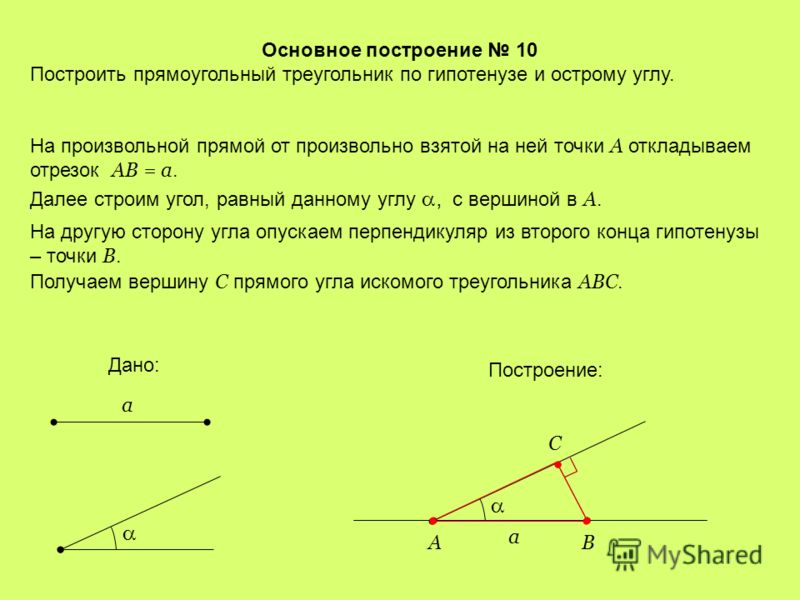
Basic construction 10 Construct a right-angled triangle according to the hypotenuse and acute angle. On an arbitrary line from a point A arbitrarily taken on it, we postpone the segment AB \u003d a. Given: a Construction: AB C a Next, we draw an angle equal to this angle with a vertex in A. On the other side of the angle, lower the perpendicular from the second end of the hypotenuse - point B. We get the vertex C at the right angle of the triangle ABC.
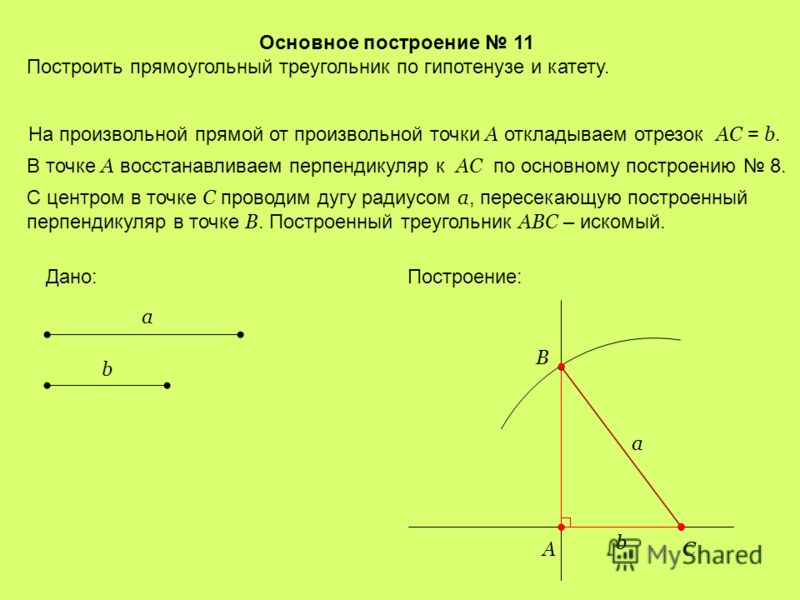
Basic construction 11 Construct a right triangle by hypotenuse and cathetus. On an arbitrary line from an arbitrary point A, we postpone the segment AC \u003d b. Given: a b Construction: A b C B a At point A, we restore the perpendicular to AC according to the basic construction 8. With a center at point C, draw an arc of radius a intersecting the constructed perpendicular at point B. The constructed triangle ABC is the desired one.

Basic construction 12 For a circle, construct a tangent passing through a given point P. Case 1. Point P lies on a circle. We draw the beam CP, where C is the center of the circle. С P A B Construction: P Given: At point P, we reconstruct the perpendicular AB to the ray CP by the basic construction 8. The straight line AB is the desired tangent.
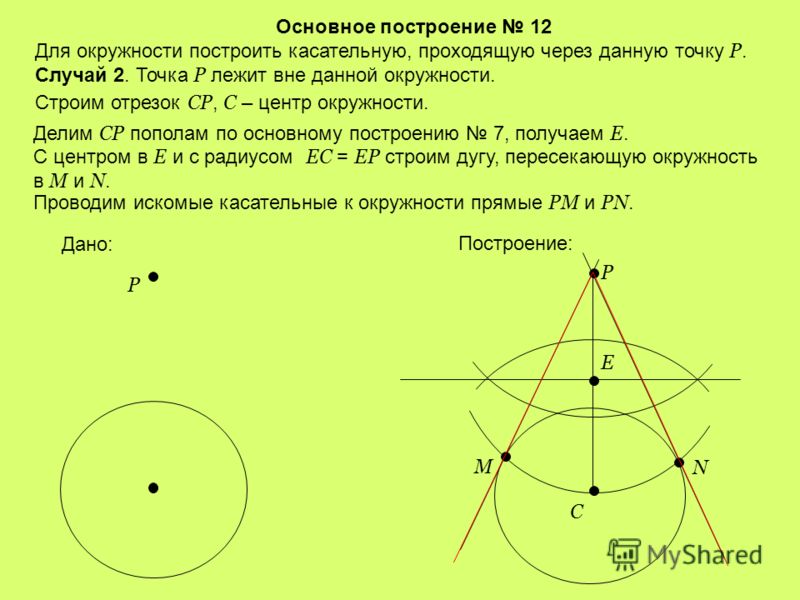
Basic construction 12 For a circle, construct a tangent passing through a given point P. Case 2. The point P lies outside this circle. With P We construct the segment CP, C is the center of the circle. Construction: M N E Divide the CP in half according to the main construction of 7, we obtain E. Draw the desired tangent lines to the circle PM and PN. Given: P With a center in E and with a radius EU \u003d EP, we construct an arc intersecting a circle in M \u200b\u200band N.
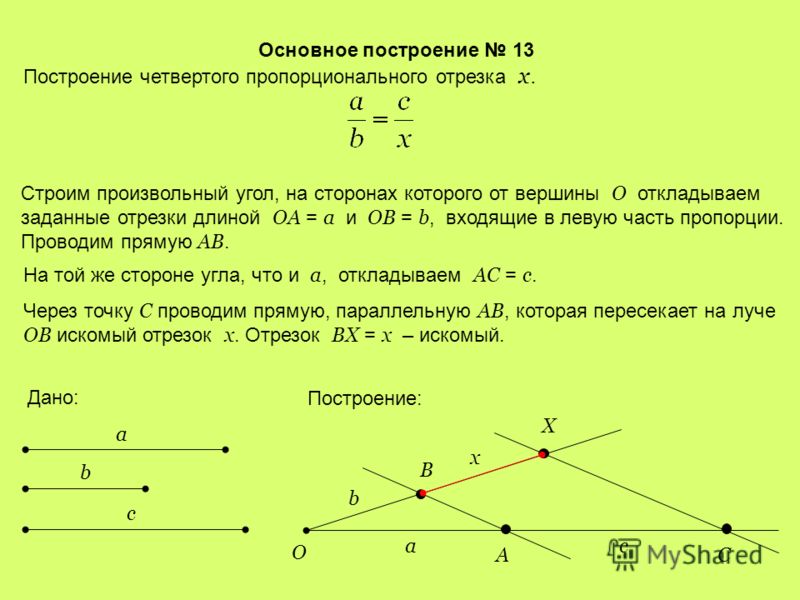
Basic construction 13 Construction of the fourth proportional segment x. We construct an arbitrary angle, on the sides of which from the vertex O we postpone the given segments of length OA \u003d a and OB \u003d b, which are included in the left side of the proportion. Draw direct AB. O B AC X Given: a b c Construction: ca b x On the same side of the angle as a, set AC \u003d c. Through point C, draw a straight line parallel to AB, which intersects the desired segment x on the ray OB. The segment BX \u003d x is the desired one.
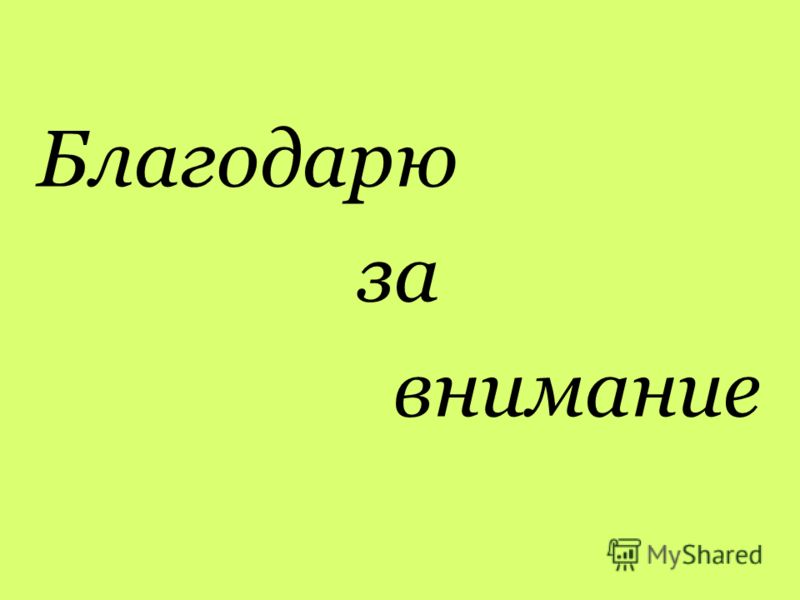
Issue 26
At the beginning of the video lesson, Professor Pythagoras wonders whether the students measured the lengths of the house. After all, this was the task of the past math lesson. It turns out that the guys completed the task, and now the teacher goes to new topic - geometric shapes using a compass. The compass is the most important geometric tool. The word circus and compasses are cognate. Both words come from the Latin word circulus, which means circle.
Why is the compass called after all, because it does not look like a circle at all? The guys became interested, why is he needed, and why does he have legs with needles? The professor explains to the guys that it is thanks to the compass that they will get acquainted with the new geometric figure. Even with two. So, the compass on the board draws a circle. This is a new figure for students. She reminds them of a circle. But the circle is the same as the circle, but inside it is hatched. A circle is also a geometric figure that can be drawn with a compass.
It turns out that the circle is part of the circle. A circle is a line, but special. All points of the circle lie at the same distance from its center. And the center of this figure is the point at which the sharp leg of the compass is placed. On the second leg of the compass is a stylus, with which he draws a circle. The distance from the center point to the circle is called the radius of the circle. The professor asks the children to give examples of objects that have the shape of a circle or circle.
The video lesson “Building with a compass and a ruler” contains educational material that is the basis for solving construction problems. Geometric constructions are an important part of solving many practical tasks. Virtually no geometrical task can do without the ability to correctly reflect the conditions in the figure. The main task of this video tutorial is to deepen the student’s knowledge about the use of drawing tools for constructing geometric shapes, demonstrate the capabilities of these tools, and teach how to solve the simplest construction tasks.
Teaching with the help of a video tutorial has many advantages, among which are the visibility and comprehensibility of the constructions being made, since the material is demonstrated by electronic means close to the actual construction on the board. Buildings are clearly visible from anywhere in the class, important points are highlighted in color. And voice accompaniment replaces the teacher’s delivery of a standard block of educational material.
The video tutorial begins with a topic title announcement. Students are reminded that they already have certain skills in building geometric shapes. In previous lessons, when students studied the basics of geometry and mastered the concepts of a straight line, point, angle, segment, triangle, drew segments equal to the data, they performed the construction of simple geometric shapes. Such constructions do not require complex skills, but the correct execution of tasks is important for further work with geometric objects and solving more complex geometric problems.
Students are given a list of the main tools that are used to complete the construction in solving geometric problems. The images show a scale ruler, pair of compasses, a triangle with a right angle, a protractor.

Expanding students' understanding of how they perform different kinds constructions, they are advised to pay attention to constructions that are carried out without a scale ruler, and for them only a compass and a ruler without divisions can be used. It is noted that such a group of construction problems, in which only a ruler and compass are used, is allocated separately in geometry.

In order to determine which geometric problems can be solved using a ruler and compasses, it is proposed to consider the possibilities of these drawing instruments. The ruler helps to draw an arbitrary straight line, to build a straight line that passes through certain points. The compass is designed to hold circles. Only with the help of a compass is an arbitrary circle constructed. With the help of a compass, a segment equal to this is also carried out. The indicated capabilities of drawing tools make it possible to perform a number of construction tasks. Among these building tasks:
- building an angle that is equal to this;
- drawing a line perpendicular to a given passing through the specified point;
- dividing a segment into two equal parts;
- a number of other construction tasks.
It is further proposed to solve the construction task using a ruler and a compass. The condition of the problem is demonstrated on the screen, which consists in putting on a certain ray a segment equal to a certain segment from the beginning of the ray. The solution to this problem begins with the construction of an arbitrary segment AB and an OS ray. As a solution to this problem, it is proposed to construct a circle with a radius of AB and a center at point O. After construction, the intersection of the constructed circle with the OS ray at some point D. is formed. Moreover, the part of the beam represented by the segment OD is a segment equal to the segment AB. The problem is solved.
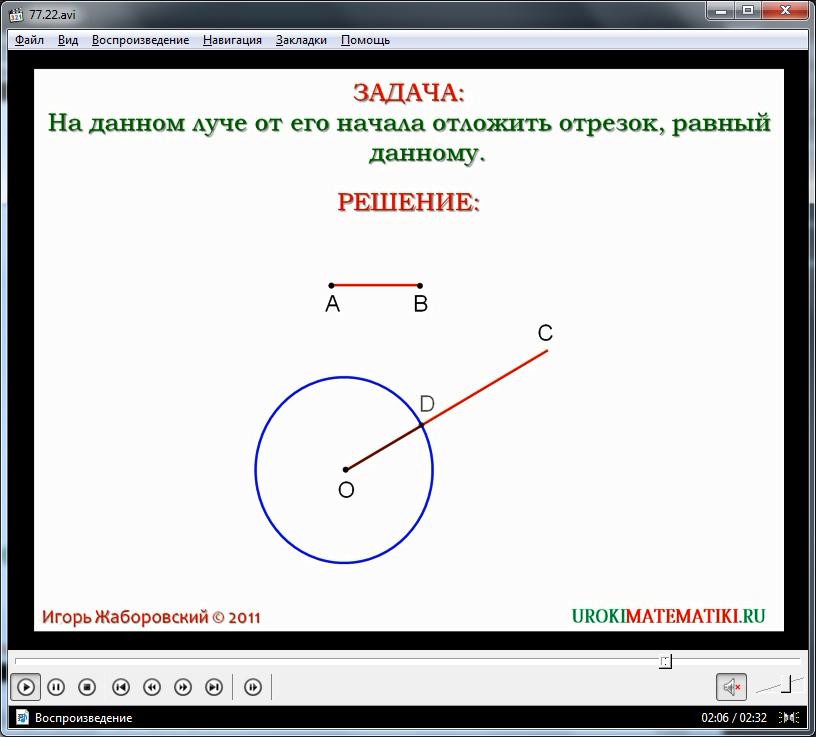
The video lesson “Building with a compass and a ruler” can be used when the teacher explains the basics of solving practical building problems. Also, this method can be mastered by independently studying this material. This video tutorial can also help the teacher with remote presentation of material on this topic.


